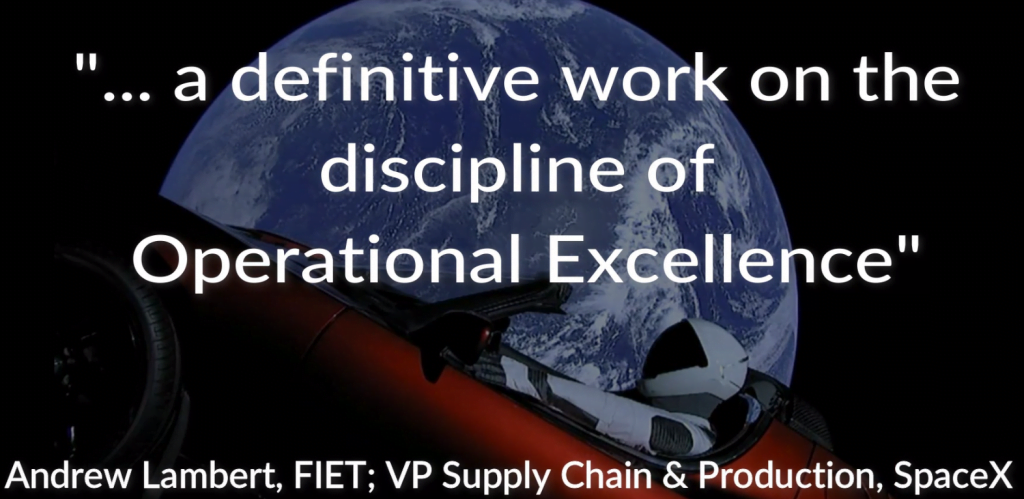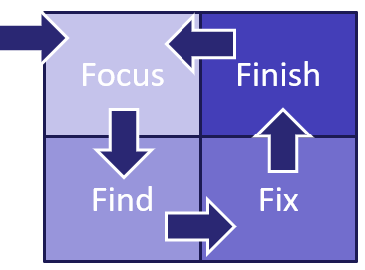Establishing Kill Chains in Business Operations
Jun 9, 2023
In my book, “State of Readiness” is a brief discussion on “Effects Chains” (pgs 271-277); which is really a re-branding (for purposes of sensibilities) of “kill chains” that I borrowed from military parlance and adapted to business.
In the context of the military, a kill chain refers to a series of stages or steps that an attacker follows to successfully carry out the attack. As such, it is a framework used to understand and analyze the various stages involved in an attack; from the initial reconnaissance to the final objective achieved by the attacker. The understanding of kill chain concepts will help to develop a plan of attack when on offense and can also be used to figure out and mitigate potential threats by understanding the attacker’s tactics and techniques if on defense.
Here is a common representation of the stages in a kill chain:
- Reconnaissance: The attacker gathers information about the target, such as; identifying potential vulnerabilities, mapping the infrastructure and available assets, or researching individuals and their capabilities within the organization.
- Countermeasure: Obscure or feign your assets and capabilities.
- Weaponization: The attacker creates or acquires the necessary assets to exploit the identified vulnerabilities. This may involve acquiring or creating specialized approaches and assets or using existing exploit kits (often in new ways).
- Countermeasure: Reconnaissance of the attacker’s assets and capabilities and disrupting their ability to prepare.
- Command and Control (C2): The attacker sets up communication channels between and among assets to collect and analyze changes in the battlefield in real time and to be able to effectively and efficiently react to those changes.
- Countermeasures: Disrupt or Infiltrate C2 structures and protocols.
- Exploitation: The weaponized payload is executed, taking advantage of vulnerabilities in the target’s systems or applications.
- Countermeasure: Anticipating the attackers means and methods of attacking and implementing proper defenses.
- Delivery: The attacker delivers the weaponized payload to the target.
- Countermeasure: Disrupt the attacker’s ability to execute their plan.
By understanding the various stages of a kill chain, organizations can develop defense strategies and implement measures to detect, prevent, or disrupt attacks at different points along the chain. It enables strategy and operations professionals to identify weaknesses and implement appropriate safeguards to protect their assets.

Effects Chains
I have had the opportunity to work closely with Matt “Boom” Daniel. Boom is a graduate of the Virginia Military Institute (VMI). After graduation, he became a Marine Aviator. He also graduated from the United States Navy Fighter Weapons School (also known as Topgun).
He and I have spoken at great length about how companies can take techniques for accelerating the decision-making process and establishing cross-functional integration that are used in the United States Armed Forces and adapt them to business. Some portions of the Operational Excellence Enterprise Readiness Model I developed—specifically, aspects of business readiness—are a direct result of those conversations and subsequent research and deliberation.
Every enterprise must have processes to conduct business. Processes are often combined and interwoven, creating more complex processes and systems. Complex processes can be difficult to track and manage without a concerted effort to horizontally integrate the people, efforts, and equipment across functional business smokestacks and divisions.
Simplistically, a widget-making business makes widgets. They must manufacture and sell their widgets. They must also package, warehouse, and distribute their widgets. They collect input from their customers, partners, and employees, and then they optimize their product and processes. None of these processes can stand alone; they are all interdependent. The company does not want to sell more product than they can make or make more than they can move.
Internally, the business collects payment on their widgets as they are sold. They pay their employees and partners, who make, distribute, and sell the product. They buy raw or processed goods to make their widgets. The business supports their workforce with infrastructure, facilities, benefits, and incentives because they want to be an attractive place to work. After all, they need people to make and move their product.
There are lots of processes that somehow nest together to ensure the business works well and makes a profit. It makes sense for the efforts to be horizontally integrated across the business to maximize efficiency, quality, and profit. Effects chains help to bin and manage such processes.
Horizontal Integration Across the Mission
An effects chain is a systems engineering tool that illustrates a sequence of events within a given complex process, called the mission. The effects chain systematically decomposes the mission, which is important for analysis. In order to identify areas of inefficiency or where the mission is working, a detailed understanding of each function’s responsibilities and metrics is necessary. The effects chain also highlights the level of horizontal integration and interoperability (across the business smokestacks, from start to finish and back) of the elements that accomplish the mission.
Effects chains are used to do the following:
- Model, visualize, and simulate business process cycles for opportunities for improvement and systems optimization.
- Understand business taxonomy for current and future operations development.
- Horizontally integrate resources and efforts within the business to enhance team awareness and team building.
- Manage business resources, plans, and personnel to support the business leader’s intent.
- Analyze the mission’s function and performance to identify key centers of gravity and high-return areas.
The Four Actions (Bins): Focus–Find–Fix–Finish:
The four actions identified in the graphic below are generic in nature, represent a nonspecific effects chain, and make up an iterative business mission loop. They illustrate the major muscle movements of a given mission. Similarly, mission-specific effects chain functions generally fall in these action bins.
- Focus. Think of the focus action as surveillance. We are looking for broader areas on which to focus our efforts from past experience or from incoming intelligence. Our field of vision should be pointed in the right direction in order to identify problems and opportunities.
- Find. After focusing on a specific domain, our sensors have picked up a target. When we find it, we identify that it is worthy of more attention and it becomes a validated target.
- Fix. Tracking a target is difficult, especially if it is moving. When we fix a target, we are finding and creating the solution for its precision engagement, and we are handing it off to the resource that will engage it.
- Finish. We engage targets after they have been located, identified, and validated. When we finish the target, we engage it and then assess the mission for success, failure, or something in between. The assessment feeds back into the beginning of the effects chain and helps focus the effort with now-improved intelligence.
Enhanced Business Execution
The efforts of the first iteration continue in an ever-narrowing refinement of tolerances, using the results from the finish bin to feed into the next (and subsequent) focus bin, continuing the improvement or refinement process in an ever-tightening loop.

Instead of a death spiral, a success spiral is created. Effects chains are used to vet and pursue big decisions. They help identify roles, responsibilities, assumptions, limitations, and constraints. Accordingly, the use of effects chains includes all the right stuff to ensure optimal horizontal integration of decisions and actions with and among each other as they progress incrementally toward mission success.
Tailored Effects Chains
Having determined the why at the beginning of the effects chain when the mission was defined, by tailoring an effects chain to a business or department, the enterprise will be able to understand which resources are playing where within the chain and who is responsible for integrating with other resources. Now, we need to quickly decide who does what, where, when, with whom, and what resources are required. And we need to know how all of this affects the entire mission and how it can be evaluated.
Most businesses think of their complex processes in a way that is unique to themselves and their own organization. It is important for a business to be able to build their own effects chains at the division level where the functions of the effects chain can be binned into the basic actions: focus, find, fix, and finish.
Understanding what resources (e.g., assets, cash, time, equipment, personnel, activities, and investments) contribute to each of the functions of the effects chain allows for a mission-based analysis of those resources. How well do the resources serve their effects chain functions and how well they interoperate are areas for analysis.
To determine your business processes and effects chains and to understand the value of these effects chains, ask yourself the following questions:
- What are your corporate missions?
- What are the business functions that must be completed to accomplish your business missions?
- Who and what (the logistics) are involved in executing your corporate missions?
- How do these logistics fit together?
- Do the logistics know where they fit together in the plan?
- How do you know if they are successful?
- What are the consequences of their individual successes or failures?
- Can we efficiently and consistently complete business effects chains?
- Where are we tripping up?
Although there are similarities between the effects chain and the OODA loop, the effects chain is designed to consider the capabilities and capacity across the entirety of the enterprise, identify the appropriate assets and resources necessary to support the mission, assess their readiness for deployment, and mobilize accordingly (strategy execution), but the OODA loop is designed to accelerate the decision-making process (strategy development).
About the Author
Paris is an international expert in the field of Operational Excellence, organizational design, strategy design and deployment, and helping companies become high-performance organizations. His vehicles for change include being the Founder of; the XONITEK Group of Companies; the Operational Excellence Society; and the Readiness Institute.
He is a sought-after speaker and lecturer and his book, “State of Readiness” has been endorsed by senior leaders at some of the most respected companies in the world.
Click here to learn more about Joseph Paris or connect with him on LinkedIn.
Original Article: https://opexsociety.org/body-of-knowledge/establishing-kill-chains-in-business-operations/
Stay In Touch.
Subscribe to our newsletter and exclusive Leadership content.


